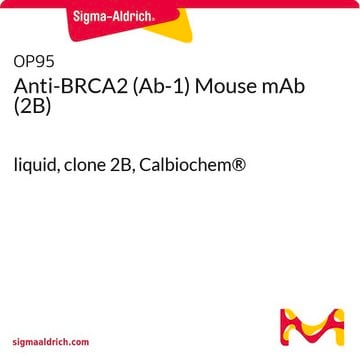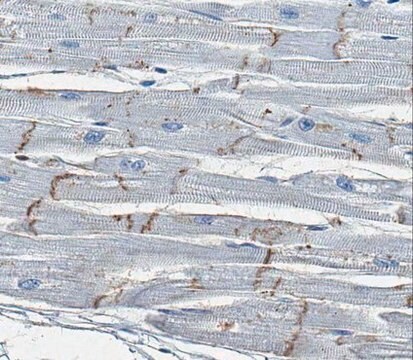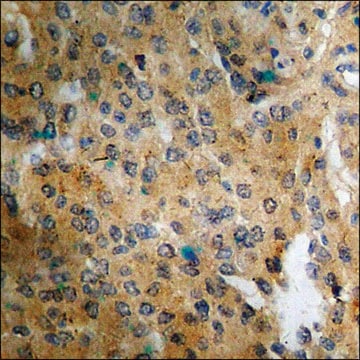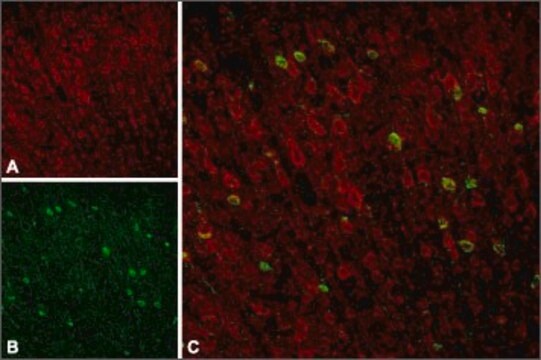AB3768
Anti-Rad54L Antibody
Chemicon®, from rabbit
About This Item
Productos recomendados
biological source
rabbit
Quality Level
antibody form
saturated ammonium sulfate (SAS) precipitated
antibody product type
primary antibodies
clone
polyclonal
purified by
affinity chromatography
species reactivity
human, mouse
manufacturer/tradename
Chemicon®
technique(s)
immunocytochemistry: suitable
immunohistochemistry: suitable
NCBI accession no.
UniProt accession no.
shipped in
dry ice
target post-translational modification
unmodified
Gene Information
human ... RAD54L(8438)
Specificity
Immunogen
application
Immunocytochemistry: 1:200-1:1,000.
Optimal working dilutions must be determined by the end user.SUGGESTED PROTOCOL FOR IMMUNOHISTOCHEMISTRY
1. Dissect tissues and freeze on dry ice
2. Cut on a cryostat - 10um slices
3. Dry slides at room temperature for 30-90 min
4. Fix with cold Acetone/Methanol (50/50) 2 min - then either process further or store at -20°C . Alternative is fixation with 4% PFA and treatment with a trypsin solution. (0.05% trypsin , incubation 10 minutes at 37°C, followed by 3 washes with PBS)
5. Let air dry
6. PBS 5min
7. Incubate in 50mM ammonium chloride 30 min
8. PBS 5min
9. Blocking serum 30-45min
10. Primary antibody 90min - dilution 1:100 - 1:600
11. Wash 3 times for 5 min
12. Secondary fluorescent conjug. antibody 30min
13. Wash 3 times for 5 min and mount
Epigenetics & Nuclear Function
Cell Cycle, DNA Replication & Repair
Physical form
PREPARATION AND USE: To reconstitute the antibody, centrifuge the antibody vial at moderate speed (5,000 rpm) for 5 minutes to pellet the precipitated antibody product. Carefully remove the ammonium sulfate/PBS buffer solution and discard. It is not necessary to remove all of the ammonium sulfate/PBS solution: 10 μL of residual ammonium sulfate solution will not effect the resuspension of the antibody. Do not let the protein pellet dry, as severe loss of antibody reactivity can occur.
Resuspend the antibody pellet in any suitable biological buffer, standard PBS or TBS (pH 7.3-7.5) are typical. Volumes required are not critical but it is suggested that the final antibody concentration be between 0.1 mg/mL and 1.0 mg/mL. For example, to achieve a 1 mg/mL concentration with 50 μg of precipitated antibody, the amount of buffer needed would be 50 μL.
Carefully add the liquid buffer to the pellet. DO NOT VORTEX. Mix by gentle stirring with a wide pipet tip or gentle finger-tapping. Let the precipitated antibody rehydrate for 1 hour at 4-25C° prior to use. Small particles of precipitated antibody that fail to resuspend are normal. Vials are overfilled to compensate for any losses.
Storage and Stability
Legal Information
Disclaimer
Not finding the right product?
Try our Herramienta de selección de productos.
Storage Class
12 - Non Combustible Liquids
wgk_germany
WGK 2
flash_point_f
Not applicable
flash_point_c
Not applicable
Certificados de análisis (COA)
Busque Certificados de análisis (COA) introduciendo el número de lote del producto. Los números de lote se encuentran en la etiqueta del producto después de las palabras «Lot» o «Batch»
¿Ya tiene este producto?
Encuentre la documentación para los productos que ha comprado recientemente en la Biblioteca de documentos.
Nuestro equipo de científicos tiene experiencia en todas las áreas de investigación: Ciencias de la vida, Ciencia de los materiales, Síntesis química, Cromatografía, Analítica y muchas otras.
Póngase en contacto con el Servicio técnico








